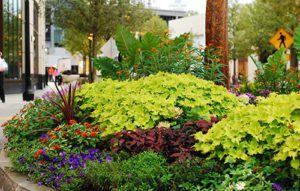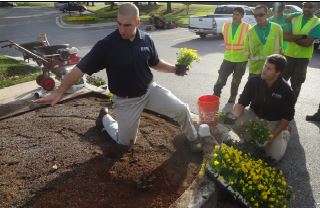By Joe Ketterer, Director of Quality and Efficiency, Landscape Management Division
 In our landscape management division, we’ve recently finished installing summer color. The timeframe for summer installation begins after the last frost-free date for that geographic area (the last day it’s expected to reach temperatures low enough for frost, based on historical weather data) and ends around Memorial Day when conditions get too hot and dry. The optimal weather conditions for flower planting are warm and moist, with enough moisture for proper root establishment.
In our landscape management division, we’ve recently finished installing summer color. The timeframe for summer installation begins after the last frost-free date for that geographic area (the last day it’s expected to reach temperatures low enough for frost, based on historical weather data) and ends around Memorial Day when conditions get too hot and dry. The optimal weather conditions for flower planting are warm and moist, with enough moisture for proper root establishment.

But it’s not just weather conditions that have to be right. The success or failure of flower installation is dependent upon good bed preparation as it determines the depth of the flowers’ root systems. You can’t just remove last year’s flowers and put in new ones – just because a bed has been planted year after year doesn’t guarantee a successful flower display this year. We have developed a 10 Step Process outlining bed prep, proper planting, mulching and watering that we must adhere to for the flowers to have their best chance at taking root and thriving.
10 Step Process
- Remove all excess debris from the flower bed – this includes mulch, plant material, roots, weeds, etc.
- Test the soil chemistry (pH balance) – the ideal pH level should be between 6 and 7 (neutral)
- Add organic compost or ‘amendments’ as necessary (add lime to raise the pH or sulfur to lower the pH)
- Use a spade to turn the subsoil along the edges of the bed, being aware of irrigation lines
- Till the soil – use a heavy rototiller where possible to achieve a depth of 8-10”
- Rake the bed smooth and apply slow-release granular fertilizer with a 14-14-14 NPK ratio. (The NPK ratio refers to the percent of Nitrogen, Phosphorus and Potassium in the fertilizer. 14-14-14 is a balanced/complete fertilizer with high amounts of nutrients.)
- Plant the flowers – establish and follow an outside line about 10”-12” away from the bed edge.
- Apply pre-emergent herbicide where necessary – this is particularly relevant for fall planting
- Top-dress the bed with organic material (composted pine fines or leaf compost when possible), tuck edges with a rake to prevent runoff, then use a blower to perform final cleanup
- Water thoroughly at high volume/low pressure and monitor closely for the first 2-3 weeks. Water approximately two times per week until plants are well established.
 Efficiency Tip: Appoint a planter and a passer – one person removes the pots and passes the plants to the person planting backward in the flower bed so as not to step over any already installed flowers.
Efficiency Tip: Appoint a planter and a passer – one person removes the pots and passes the plants to the person planting backward in the flower bed so as not to step over any already installed flowers.
There are no shortcuts to the 10 Step Process. The more discipline we have when executing these steps, especially those pertaining to proper bed prep, the better quality flower display will result. By enabling plants to develop a deep root system, less watering will be required over the plant’s life and will also give them a better chance of withstanding environmental extremes such as heat, drought, insect and disease pressure.